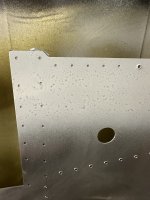I recently ran into some issues that I'm unable to solve with my white, two-part epoxy primer.
I've utilized this product successfully on other parts, but recently I started getting spots in the first coat. I thought it was moisture, so I bled the tank, lines, etc. but to no avail. I added a desiccant filter and another moisture trap--still no improvement.
It happens on any surface, even the plastic booth wall and untreated aluminum.
Another forum mentioned that I might be applying too thick. I'd agree, that for a first coat this appears thick, though I did spray it twice once the spots appears as an initial gut reaction to "cover" them up. (I quickly realized the only way to salvage this was to abandon the pot of paint and clean off what was sprayed.)
Does anyone know what this could be? I'm not the best or most experienced with paint--in fact I likely rant toward the bottom of that list, so feel free to offer up even the most basic of suggestions.
I've utilized this product successfully on other parts, but recently I started getting spots in the first coat. I thought it was moisture, so I bled the tank, lines, etc. but to no avail. I added a desiccant filter and another moisture trap--still no improvement.
It happens on any surface, even the plastic booth wall and untreated aluminum.
Another forum mentioned that I might be applying too thick. I'd agree, that for a first coat this appears thick, though I did spray it twice once the spots appears as an initial gut reaction to "cover" them up. (I quickly realized the only way to salvage this was to abandon the pot of paint and clean off what was sprayed.)
Does anyone know what this could be? I'm not the best or most experienced with paint--in fact I likely rant toward the bottom of that list, so feel free to offer up even the most basic of suggestions.





